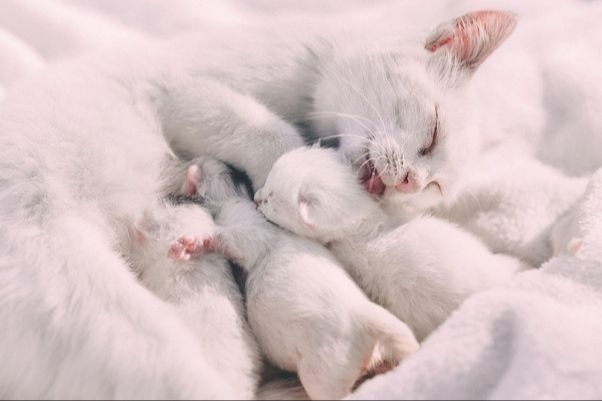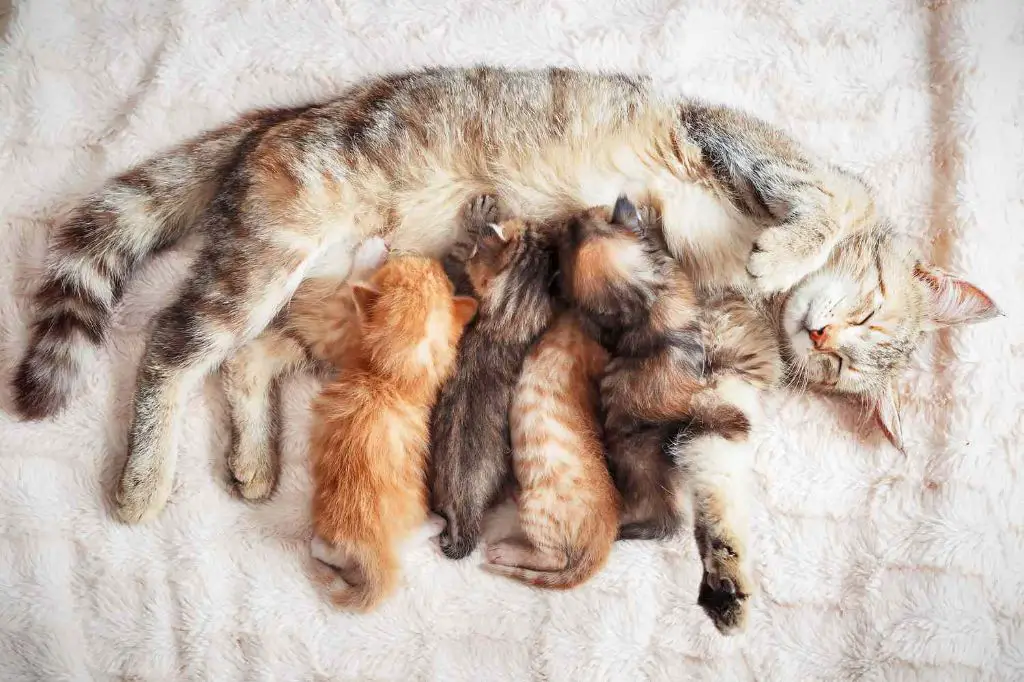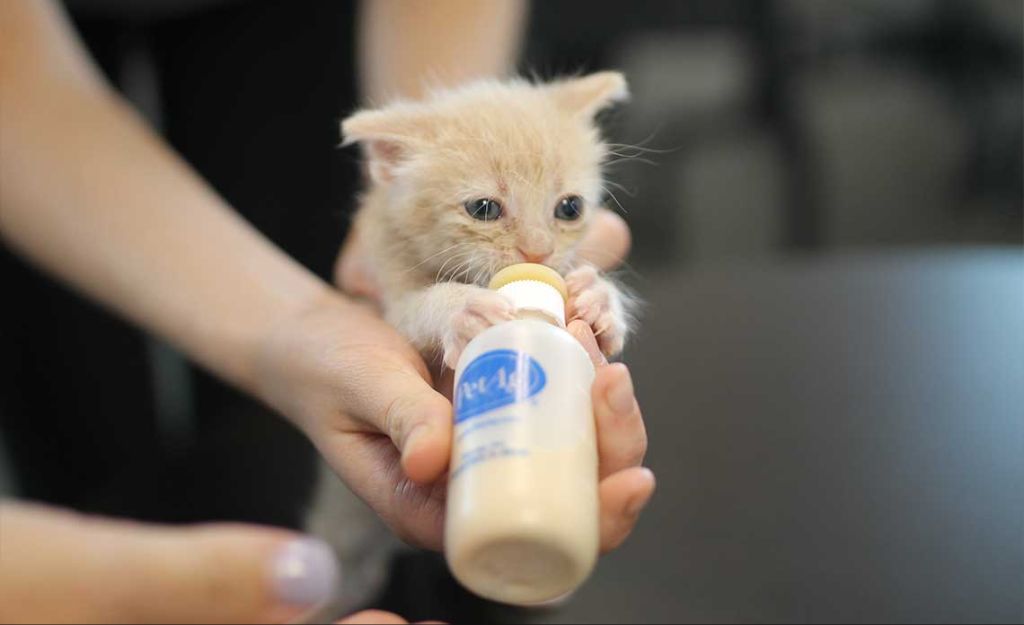The relationship between a mother cat and her kittens is usually loving and nurturing. However, in rare cases, some mother cats may harm or even kill their own kittens. Kitten mortality can occur for various reasons, some natural and others due to external factors causing the mother stress. It’s important for cat owners to understand the reasons behind this behavior and know the signs of trouble. This content will provide an overview of maternal behavior in cats, causes of kitten mortality, why a mother cat may turn on her kittens, ways to prevent harm, intervention methods, and alternate kitten care solutions.
Maternal Behavior
Mother cats have a strong instinct to nurture and protect their kittens. Immediately after birth, the mother licks each kitten to clean it and stimulate breathing. She will sever the umbilical cord and eat the afterbirth, which provides her with nutrients and helps keep the nest clean.
The mother cat is very attentive in the first few weeks, nursing, grooming, and keeping the kittens warm. She will move them frequently to avoid detection by predators. By about 4 weeks old, the kittens are more mobile and the mother will bring them food. She will continue to care for them until they are weaned at around 8 weeks old [1].
While mother cats may sometimes struggle with maternal behavior, especially very young or first-time mothers, they are hardwired to protect and nourish their young. With proper support, the majority of mother cats will demonstrate appropriate maternal instincts.

Causes of Kitten Mortality
There are many common causes of kitten mortality that are unrelated to the mother cat. Congenital defects, infections, and malnutrition are some of the most common reasons kittens die in the first few weeks of life (Source). Kittens that do not receive adequate nutrition and calories in the first couple weeks are at high risk for failure to thrive, which can be fatal. Underlying illnesses like viral infections can also claim the lives of young kittens. Kittens with weak immune systems are prone to contracting viruses and bacteria that their bodies cannot fight off. Without proper medical care, these types of infections can overwhelm a kitten’s body and lead to death.
Why a Mother Cat May Harm Kittens
While the idea of a mother cat harming her own kittens may seem counterintuitive, there are some reasons why this unfortunately can occur in some situations. According to research, the most common causes have to do with the mother cat’s instincts and her ability to provide for the litter.
Stress is one major factor that can lead a mother cat to harm her kittens. Giving birth to and caring for a litter is extremely taxing physically and mentally on a female cat. If the mother feels unable to properly care for her kittens due to stress, her natural instincts may drive her to cull the litter by killing the weak or sick ones. This removes the burden of caring for more kittens than she can handle. [1]
Lack of resources like food, water, shelter, warmth and nesting areas can also lead mother cats to kill their kittens. If she cannot provide adequately for them all, her instincts take over to preserve herself and the strongest kittens most likely to survive. Illness or malnutrition in the mother cat can also severely diminish her physical capability to care for a litter. [2]
Finally, health issues or deformities in individual kittens can trigger a mother’s instincts to cull and kill them. Kittens that seem unlikely to survive or are too weak to compete for resources may be killed by the mother for the good of the rest of the litter. While tragic, this behavior serves an evolutionary purpose for cat survival. [3]
Infanticide in Cats
Infanticide, the killing of young offspring by a parent, occurs in many mammal species including cats. Though shocking, infanticide is often an instinctual behavior relating to resource competition or population control.
Studies show infanticide in feral cat colonies can account for over 50% of kitten deaths in the first 6 months of life.1 Factors triggering feline infanticide include:
- Limited resources like food, shelter, mates
- Offspring from an unwated mating
- Offspring that are weak, ill or deformed
- Stress from overcrowding
- Inexperience with maternal behaviors
Though difficult to accept, infanticide allows cats to conserve resources and focus care on the strongest kittens with the best chance of surviving. It’s an instinctive feline behavior, not an act of cruelty.
Preventing Harm
There are several things cat owners can do to prevent a mother cat from harming her kittens:
Proper care: Make sure the mother cat is getting proper nutrition and is free from stress during pregnancy and nursing. Provide a quiet, comfortable, and safe nesting area away from other pets and children. Clean the area regularly to prevent illness. Spaying the mother to avoid unwanted litters can also reduce maternal stress.

Source: https://www.quora.com/Why-did-my-cat-kill-her-kittens
Spaying/neutering: Spaying the mother cat and neutering the father will prevent unwanted pregnancies that can overwhelm or stress the mother. It also avoids complications that may lead a mother to reject kittens. Kittens should be spayed/neutered as soon as recommended by a vet to prevent future unwanted litters.
Source: https://www.reddit.com/r/Pets/comments/10u7hk/friends_cat_trying_to_kill_her_kittens/
Veterinary checks: Take the mother cat and kittens to the vet for check-ups before and after birth to monitor their health. Sick or weak kittens are more likely to be rejected or harmed. The vet can examine the queen’s maternal behavior and advise on any issues.
Signs of Trouble
There are some concerning signs that may indicate a mother cat is struggling with her maternal instincts and may harm her kittens. These include:
- Aggression – A mother cat who suddenly becomes aggressive with her kittens, hissing, swatting, or biting at them.
- Neglect – Failure to nurse, groom, or care for the kittens. She may ignore their cries for attention.
- Moving Kittens – Frequently moving the kittens from place to place instead of settling in one nest. This may indicate stress or rejection of the kittens.
According to the Quora article, stress is one factor that can cause a mother cat to become aggressive or act out against her kittens[1]. Any major change in a mother cat’s behavior around her kittens should be seen as a red flag.
Intervention
It is best to wait until kittens are at least 8-12 weeks old before separating them from their mother, according to experts. This allows time for proper socialization and for the kittens to be weaned off their mother’s milk [1]. However, sometimes it becomes necessary to separate kittens earlier, such as if the mother cat is rejecting or harming her kittens.

If you need to separate kittens before 8 weeks of age, here are some tips:
- Separate the kittens into their own clean, warm, and quiet area with soft bedding. Make sure they are eating kitten food and drinking water.
- Check on the kittens frequently and watch for signs of dehydration or failing health. Very young kittens may need supplemental bottle feeding with kitten milk replacement formula.
- Spend time socializing the kittens through cuddling, playing, and gentle handling. This helps prevent behavior issues down the line.
- Reunite kittens with their mother for supervised feedings if possible. Then return them to their separate area.
- Consult a veterinarian for medical advice if needed.
Kittens do best remaining with their mom and littermates for 8-12 weeks. But taking action to separate kittens earlier can be necessary when the mother cat poses a danger.
Alternate Care
If a kitten has been separated from its mother, it will need special care in order to survive. There are a few options for providing alternate care:
Bottle Feeding: Kittens under 4 weeks old cannot eat solid food and will need to be bottle fed a kitten milk replacement formula every 2-3 hours. It’s important to use kitten formula specifically as regular milk can cause diarrhea. The bottles, nipples, and formula need to be warmed to body temperature. Care should be taken to feed slowly and avoid overfeeding, which can cause aspiration pneumonia.
According to Orphaned Kitten Care How to, kittens should be fed while in an upright position and burped afterwards like a human baby.
Fostering: Taking in an orphaned kitten temporarily can help provide the intensive care required until the kitten is weaned. Experienced fosters can assist with bottle feeding, socialization, sanitation, and monitoring weight and health until the kitten is old enough for adoption.

Vet Checkups: Orphaned kittens are at high risk for health issues like infections, parasites, and malnutrition. Regular vet checkups are crucial for catching any problems early on when they are most treatable. Vaccinations and deworming should be done on schedule. The vet can advise on proper nutrition and supplemental care.
Conclusion
While the idea of a mother cat harming her kittens seems unnatural, it does sometimes occur in the wild for various reasons. With domestic cats, proper prenatal and postnatal care from their human guardians can prevent most causes of kitten mortality. Though rare, even well-cared for mother cats may reject or unintentionally harm kittens on occasion. Being alert to signs of trouble and promptly intervening can help save affected kittens.
With attentive care from humans, the strong maternal instincts of cats ensure that the vast majority of kittens survive and thrive. While infanticide does happen, it is relatively uncommon in domestic cats. With proper prenatal and postnatal care, plus supervision of mother and kittens, cat guardians can help promote healthy, loving families.

